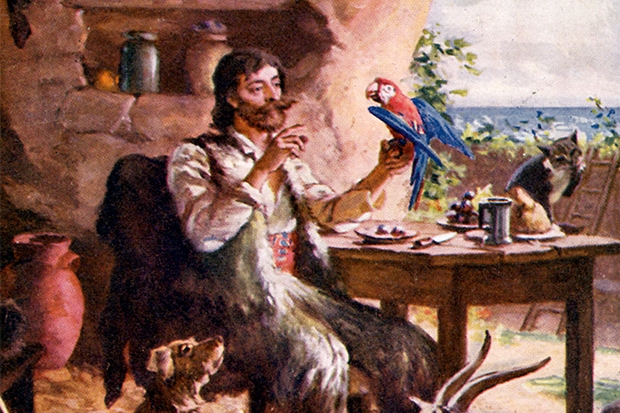Some years ago, when I stepped from an unstable boat onto Juan Fernández island, a friendly man took my bag and introduced himself as Robinson. Ten minutes later, I found a room to rent. The homeowner’s first name was Crusoe. Get the idea? Although Defoe set his story hundreds of miles away, near the mouth of the Orinoco, Juan Fernández was where the real Crusoe, the Scottish sailing master Alexander Selkirk, spent four years and four months in the company only of goats.
Andrew Lambert has had the very good idea of writing a kind of historical biography of the 15×5-mile lump of volcanic rock 415 miles off the coast of Chile (he includes the other two smaller islands in the archipelago). A distinguished naval historian — the author among other books of Nelson: Britannia’s God of War — Lambert is an excellent researcher who has excavated many sources. He takes the reader on a steady voyage, from the moment the uninhabited islands emerged from the gloom of geographical ignorance after the Spaniard Fernández discovered them in the 16th century.
The tale involves piracy, the South Sea Bubble, fish ‘so plentiful that in less than one hour’s time two men caught enough for our whole company’ (this in the 1680s), whaling, sealing, shifts in imperial ambition following Britain’s loss of America, evolving global trade patterns and the fashion for oceanic travel books.
Crusoe’s Island is a serious work that will remain the standard history for some time. Lambert’s avowed main interest is ‘the long, curious relationship between English identity and an island on the other side of the world’. Britain never owned the archipelago, but flirted with occupation: before the age of steam, the islands provided a crucial victualling station en route to all points west. The book benefits from the specificity that only a naval historian would bother with — for example, the fact that two forges were set up on Juan Fernández to repair ships’ chain plates. Some of the best pages record how 18th-century mariners learned what to eat.
Lambert is on less sure ground when conjuring the magic of literature. Robinson Crusoe and Gulliver’s Travels, we learn, ‘provided a complex mix of agendas and ideologies to contemporary readers’. Through these and other books, Lambert reckons that lonely Juan Fernández ‘played a critical role in expanding English intellectual horizons’. I am not convinced. The author is stronger, however, on Defoe’s political aims, and gives an excellent account of the competing versions of the truth about the maverick Selkirk.
Besides many other works, Defoe published two major books on trade, together forming ‘a manifesto for an ever-expanding global economy, centred on London, linked by sea’. But in the public imagination he is now solely remembered for Robinson Crusoe, a story which, as Lambert says, has ‘survived the shifting patterns of culture and taste across three centuries’. In an effort to boost tourism, the Chilean government has officially renamed Juan Fernández Robinson Crusoe.
The Pyrenean goats who dwelt with Selkirk had been introduced by sailors to provide protein for future scorbutic mariners. Lambert quotes a contemporary source which claims that Selkirk had another use for the goats, marking the animals’ ears, bedpost-notch style. Yikes.
For two centuries, travellers, convicts and Spanish soldiers intermittently settled. But the opening of the Panama Canal in 1855 ended the age of heroic voyaging and removed the strategic value of the islands, which had become Chilean on that country’s declaration of independence. The island featured in the first world war when the British cornered and sunk the German light cruiser Dresden in Cumberland Bay.
Lambert visited the Pacific outpost as a member of a German film team. He includes almost no material on the contemporary scene: I would have liked more — in particular the sound of local voices. The modern archipelagic economy, supporting a population of 900, depends on the cooperative fishing of an indigenous pincer-less lobster (Jasus frontalis), flown weekly to Santiago and sold for high prices. I once went out with a couple of fishermen to collect these spiny beasts from lonely ocean cages. Eight hours without a lav. But we cooked lobster for lunch over a fire in the belly of the boat.






Comments